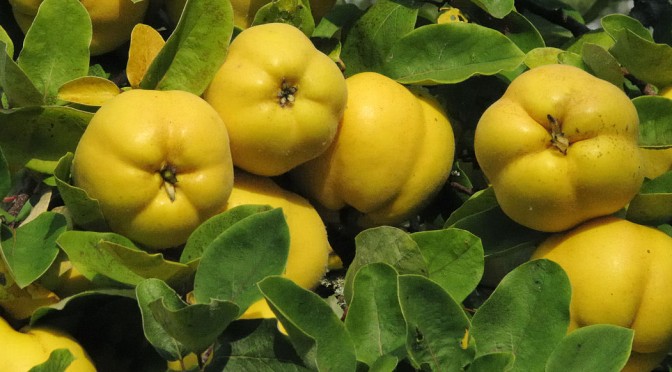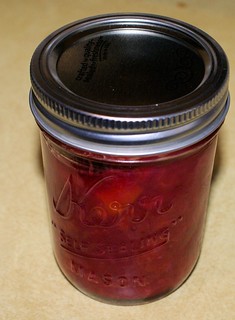The only quince I knew when I was growing up was my Great Uncle Quince and I always thought it an unusual name. For many years, I had no idea it was also a fruit. I didn’t actually try that fruit until about two years ago when I found some at one of the local grocery stores. Although they look like an apple, they are not and you don’t eat them raw. They must be cooked. Once cooked, they taste similar to an apple and they pair very well with apples and pears. Even though they are related, the quince is the only one in its genus, which is Cydonia, although it is part of the Rosaceae family, along with apples and pears. So, related but not… does this make them like an in-law?
Like many fruits and vegetables, the quince has a long history that goes back to ancient Asia, Turkey, Iran and pretty much the rest of the Mediterranean. Although it likes the rocky slopes and woodland marshes of southwest Asia, do not confuse it with the Chinese Quince. The Akkadians called it supurgillu. The modern name came from 14th century France as a plural form of quoyn. The Greeks called it kydonion melon or kydonian apple.
It is possible that quince may have been cultivated before apples and it may be that many references translated to apple may actually have been quince. Customs surround the quince. Ancient Greeks used it a ritual offering at weddings because it had come from the Levant with Aphrodite and was sacred to her. The Greek bride would nibble on quince to perfume her breath prior to entering her bridal chamber. Paris awarded Aphrodite a quince and it was for a golden quince that Atalanta paused in her race. The Roman Apicius cookbook had recipes for stewing quince with honey and even combining them with leeks.
In the past, quince was once a staple in kitchens world-wide but now it is a novel fruit and is not seen too often. I can find it in the fall at one grocery store in Reno. There is a pineapple quince variety that grows in California, but the majority of them are imported from South America. Although interest has diminished in North America, it is still popular in many Latin American countries.
Uses
How is is used in different cultures? In many ways. In Moroccan, Persian, Romanian and Balkan cuisine, it is used as a confection. Quince can be added to meaty stews and in much the same way as apples or pears. Called melimelum by the Romans, the Greek name means “honey apple” because the fruit was preserved in honey for jam. The Portuguese called it marmelo, a name that combines melimelum and marmelado, which was a favorite confection. The British used it in tarts and pies.
With a high pectin content, quince is easy to turn into marmalade, conserves, jams or jelly. They can be poached, stewed, baked and pretty much treated as a cooked apple. You just can’t eat them raw. They should be cored and peeled before use. An easy way to peel them is to par boil them for about three minutes, then the skin slides right off.
Nutrition information for 1 fruit, peeled and cored
Calories: 52 Fat: 0.1 g Net Carbs: 9.7 g Protein: 0.4 g
Quince Apple Jam

Adapted for low carb by Rene Averett
Easy to make and will only store a few weeks. Quince may be found in the fall and there are places where you can order it online. If you make more than you can eat in two or three weeks, freeze part of the batch in a freezer bag and store for several months.
1 Quince
1 Cooking Apple
1 cup sugar substitute (xylitol, like Ideal sugar)
2 cups of water
1 Tbs lemon juice
Peel and grate, or finely chop, the apple and the quince.
Bring the water to a boil and add the grated or chopped fruit. Let them cook, stirring now and then, until they are soft, about 10 minutes. Add the sugar substitute and lemon juice, lower the cook temperature to medium and continue to cook until the sauce thickens to a jam. Let cool, then ladle into a clean jar and store in refrigerator.
Makes about 1 cup of jam. About 16 servings.
Nutrition info per tablespoon of jam (1 serving)
Calories:9.7 Fat: 0.0 Net Carbs: 2.6 g Protein: 0.1 g
Sources for information in this blog include Specialty Produce,
Wikipedia, Nature’s Pride and Nutrition and You
Photo at top from Wikimedia Commons, used with permission – “Quitte Cydonia oblonga” by Dietrich Krieger – Own work. Licensed under CC BY-SA 3.0 via Wikimedia Commons –









